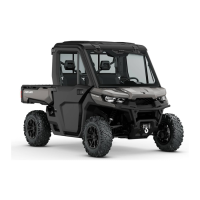RIDING YOUR VEHICLE
Practice Exercises
Before you go out for a ride, it is very
important to familiarize you r se lf with
thehandlingofyourvehiclebyprac-
ticing in a controlled environment. If
possible, it is also a very good idea to
take a more formal training course to
sharpen your skills an d increase your
knowle dge of the ve hicle.
Find a suitable area to practice and
perform the following exercises. It
should be at least 45 m (150 ft) by 45 m
(150 ft) free of obstacles like trees and
rocks. Once you’ve selected a s uitable
permitted location, proceed with the
following exercises.
Turning Exercises
Turning is one of the most frequent
causes of accidents. It is easier for the
vehicle to lose traction or rollover if you
turn too sharply, or go too fast. Slow
down when you approach a turn.
– First learn how to perform slight
right turns at very low speeds. Re-
lease the throttle before turning and
slowly reapply the throttle when
turning.
– Repeat turning exercise but this
time maintain the throttle at the
level while turning.
– Finally, repeat turning exercise
while accelerating slowly.
– Practice exercises turning on the
other side.
Note how your vehicle reacts in these
different exercises. We recommend
releasing the throttle before entering a
turn to help initiate directional ch an ge .
You will feel the lateral force increasing
with the speed and with your steer-
ing input. The lateral force should be
maintained as low as possible to make
sure it does not cause the vehicle to
roll over.
UTurnExercises
Practice doing U turns.
– Accele rate slowly and while remain-
ing at low speed, then gradually turn
the steering wheel to the right until
you have completed the U turn.
– Repeat U turn exercise with differ-
ent steering inputs and always at a
very low speed.
– Repeat U turn exercise on the other
side.
As mentioned before in this guide, do
not ride on paved surfaces as the ve-
hicle behavior will not be the same,
increasing the risk of rollover.
Braking Exercises
Practice braking to get familiar with the
brake response.
–Doitatlowspeedfirst,thenin-
crease the speed.
– Practice braking in straight line at dif-
ferent speeds and different braking
force.
– Practice em ergency braking; opti-
mal braking is obtained in straight
line, with high force applied, with-
out locking the wheels.
Remember, braking distance depends
on vehicle speed, load and the type of
surface. Also, the tires and brakes con-
ditions play a major role.
Reverse Exercises
The next step involves using the re-
verse.
– Insta ll 1 con e marker on bo th sides
of the vehicle beside each rear
wheel. Move the vehicle forward
until you can see the cone markers,
then stop the vehicle. Acknowl-
edge the distance required to see
obstacles behind you.
– Learn how the vehicle handles itself
in reverse a nd reacts with steering
inputs.
– Alwa ys perform this reverse exer-
cise at slow speeds.
________
SAFETY INF
ORMATION
________
21

